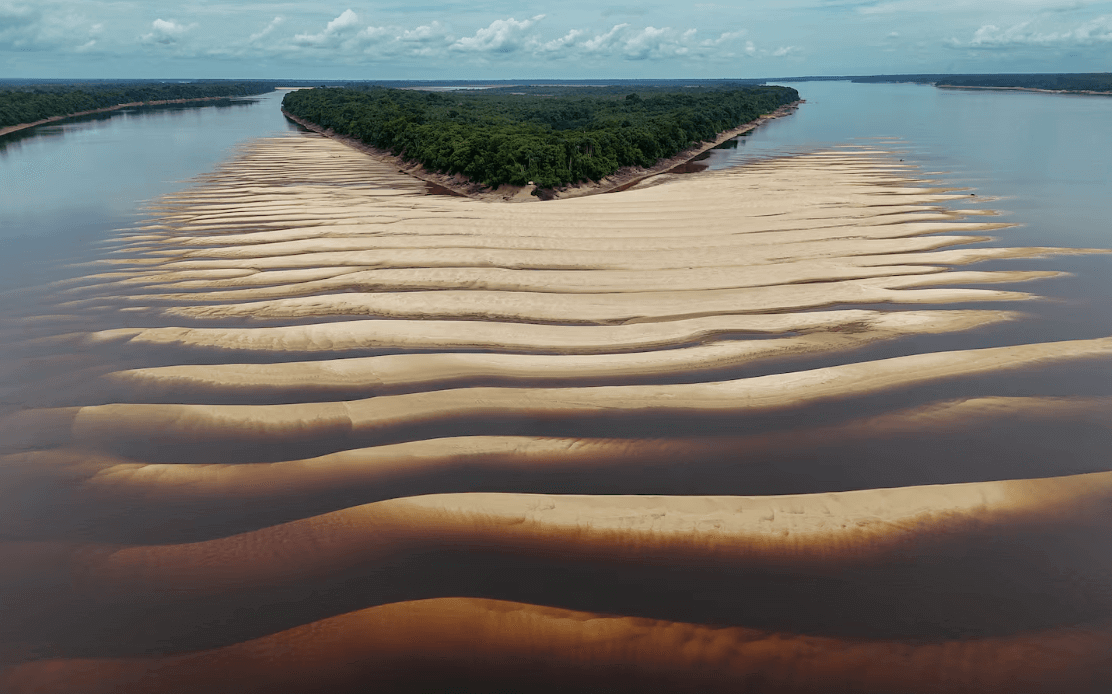气候变化正在灼烧世界上最大的河流

【中美创新时报2024 年 10 月 7 日编译讯】(记者温友平编译)世界上最大的河流干涸了。亚马逊河因气候变化而接连遭受干旱,正在干涸,这条浩瀚水道的一些河段缩小到只有几英尺深的浅水池。《纽约时报》记者Ana Ionova对此作了下述报道。
根据巴西地质局的数据,亚马逊河蜿蜒近 4,000 英里,横跨南美洲,上个月,该河几段的水位降至有记录以来的最低水平。
该机构自 1967 年开始收集数据,据该机构称,在巴西亚马逊州的一段河段,该河水位比往年同期的平均水平低 25 英尺。
亚马逊河三条最重要的支流(它们本身就是主要河流,每条河流长度超过 1,000 英里)的部分水位也降至历史最低水平。
这场危机使亚马逊河陷入瘫痪,这条重要的水上高速公路实际上是连接森林社区和在地球上一些最偏远的河段之间进行商业活动的唯一途径。

面对没有缓解迹象的局面,巴西采取了一项不久前可能难以想象的非常措施:加深这条世界上最大的河流。
从本月开始,该国计划开始疏浚河流的部分区域,以确保即使在干旱时期,人员和货物也能继续穿越雨林。
“在一些地方,我们几乎可以看到河面上的植被,”水位如此之低,以至于河床上的植物都暴露在外,联邦机构国家交通基础设施部主任法布里西奥·德·奥利维拉·加尔旺说。“所以,这限制了航行。人们无法像这样旅行。”
水位大幅下降使得船只难以接送儿童上学、将病人送往医院或将药品和饮用水送到遥远的村庄。
在本月的地方选举之前,投票机可能需要空运到数千名无法到达附近城市中心投票的滞留巴西人那里。
交通混乱也影响了主要的国际制造业中心马瑙斯,这座位于雨林中心的 200 万人口的城市。浅水使货船难以停靠。因此,公司拼命建造浮动码头,以便从集装箱中卸下物资,最大限度地减少供应链中断。
“抵达这里的所有东西通常都是乘船来的,”马米拉乌阿研究所的水文学家阿扬·桑托斯·弗莱施曼说,马米拉乌阿研究所是位于亚马逊州农村地区的一个研究机构。“没有河流,几乎就没有办法在亚马逊河上航行。”
过去,巴西当局曾在罕见的紧急情况下疏浚亚马逊河。但加尔旺说,为了应对可能出现的长期干旱情况,现在将在未来五年内不断开凿河床。
“这样我们就不会在未来几年遭受损失,”他说。
亚马逊河是世界上流量最大的河流,也是最长的河流系统,发源于秘鲁安第斯山脉,穿过五个国家,然后流入大西洋。这里是各种水生生物的家园,比如食人鱼和粉红河豚。在一些地区,这条河仍然很深——深达 400 英尺——可以容纳远洋班轮。
尽管如此,疏浚计划凸显了世界各国政府被迫采取的严厉措施,以减轻极端天气对交通、经济和日常生活的影响。
它还凸显了更热、更干燥的气候如何重塑亚马逊雨林,亚马逊雨林是地球上最大的淡水水库,也是减缓全球变暖的关键部分,因为丛林吸收并储存了大气中的吸热气体。
“气候正在变化,”加尔旺说。“我们开始为此做准备。”
在巴西,就像世界其他地方一样,平均气温正在上升,造成了干旱。巴西圣卡塔琳娜联邦大学的研究员贝尔纳多·弗洛雷斯说,自 1980 年代以来,亚马逊一些地区的平均气温上升了 2%,并且还有进一步上升的趋势。
研究机构 IPAM Amazônia 科学主任 Ane Alencar 表示,每年的旱季通常从 6 月持续到 10 月,今年的旱季尤其严峻,因为亚马逊连续两年遭受严重干旱。
而厄尔尼诺现象的持续影响降低了雨季的降雨量。
“河流没有机会恢复,”Alencar 说。“所以我们看到了多米诺骨牌效应。”
当局希望疏浚能带来一些缓解。实际上,这涉及从亚马逊四条战略性河段中挖出变得太浅的沉积物,并将其沉积到水更深的其他区域。
Galvão 表示,这一过程几乎没有环境风险,但当局将监测水质及其对鱼类的影响。
但一些科学家不同意,他们警告说,疏浚亚马逊及其支流可能会对水生系统留下持久的痕迹,破坏并可能伤害动植物。
首先,它可以挖掘出埋藏的汞矿,汞通过土壤的自然侵蚀渗入河流,也是非法金矿径流的结果。
通过搅动河床,鱼类和其他水生生物将接触到更多的有毒化学物质。汞可以抑制物种的繁殖、生长和神经发育,并在通过食物链时变得更加有害。
“沉积物是随着时间的推移而积累起来的一组沉积物,”巴西马瑙斯亚马逊研究所的生物学家阿达尔贝托·路易斯·瓦尔说。“弄乱这些沉积物就像弄乱了所有的历史。”
即使疏浚缓解了亚马逊及其主要支流的拥堵,连接农村地区和城市中心的小河仍有可能继续干涸,使许多土著村庄和渔业社区陷入孤立,弗洛雷斯说。
“当我们从整个亚马逊人口的角度考虑时,这并不是真正的解决方案,”他说,并指出建造更多水井和安装雨水收集系统可以让偏远社区更好地应对更频繁的干旱。
尽管如此,疏浚计划对像 Tauary 这样的社区来说还是个好消息,Tauary 是亚马逊州最干旱地区之一的河畔村庄。据一位居民 Maria de Fátima Servalho Celestino 称,干旱使 35 个家庭与世隔绝,几乎无法离开。
“在这里,河流就是我们的街道,”34 岁的 Celestino 说。“干旱让我们无法进城买水或药。我们无法捕鱼,鱼都不见了。一切都干涸了。”
本文最初发表于《纽约时报》。
题图:10 月 1 日,巴西北部亚马逊州新艾劳阿纳维尔哈纳斯群岛内格罗河河床上的沙洲鸟瞰图。MICHAEL DANTASMICHAEL DANTAS/AFP via Getty Images
附原英文报道:
A changing climate is scorching the world’s biggest river
By Ana Ionova New York Times,Updated October 6, 2024
Aerial view of a sandbank on the bed of the Negro River, in the Anavilhanas Archipelago, in Novo Airao, Amazonas state, northern Brazil, on Oct. 1.MICHAEL DANTASMICHAEL DANTAS/AFP via Getty Images
RIO DE JANEIRO — The world’s largest river is parched.
The Amazon River, battered by back-to-back droughts fueled by climate change, is drying up, with some stretches of the mighty waterway dwindling to shallow pools only a few feet deep.
Water levels along several sections of the Amazon River, which winds nearly 4,000 miles across South America, fell last month to their lowest level on record, according to figures from the Brazilian Geological Service.
In one stretch in the Brazilian state of Amazonas, the river was 25 feet below the average for this time of year, according to the agency, which began collecting data in 1967.
Parts of three of the Amazon River’s most important tributaries — major rivers in their own right, each spanning more than 1,000 miles — have also fallen to historical lows.
The crisis has gridlocked the Amazon, a vital watery superhighway that serves as practically the only way to connect forest communities and move commerce around some of the most remote stretches on the planet.
Faced with a situation that shows no sign of abating, Brazil has resorted to an extraordinary measure that might have been unthinkable not too long ago: making the world’s largest river deeper.
Starting this month, the country plans to begin dredging sections of the river with the aim of ensuring that, even in times of drought, people and goods can keep moving through the rainforest.
“In some places, we can practically see the vegetation on the surface of the river,” the water so low that plants on the riverbed are exposed, said Fabricio de Oliveira Galvão, the director of the National Department of Transport Infrastructure, a federal agency. “So, this limits navigation. People aren’t able to travel like this.”
The remarkable drop in water levels has left boats struggling to shuttle children to school, rush the sick to hospitals, or deliver medicine and drinking water to distant villages.
Before local elections this month, voting machines may need to be flown to thousands of stranded Brazilians unable to reach nearby urban centers to cast ballots.
Transportation chaos has also hit the major international manufacturing hub of Manaus, a city of 2 million in the heart of the rainforest. Shallow water has made it difficult for cargo ships to dock. So companies have worked furiously to build floating docks where they can unload supplies from shipping containers, minimizing supply chain disruption.
“Everything that arrives here usually comes by boat,” said Ayan Santos Fleischmann, a hydrologist at the Mamirauá Institute, a research organization in a rural part of Amazonas state. “Without the rivers, there’s almost no way to navigate the Amazon.”
In the past, the Brazilian authorities have dredged the Amazon River in rare emergencies. But the riverbed will now be carved out continuously for the next five years to cope with the possibility of chronic drought conditions, Galvão said.
“It’s so we don’t suffer in the coming years,” he said.
The Amazon is both the world’s largest river by volume and the longest river system, emerging in the Peruvian Andes and crossing five countries before emptying into the Atlantic Ocean. It is home to a rich variety of aquatic life, like piranhas and pink river dolphins. In some areas, the river is still very deep — up to 400 feet — and can accommodate ocean liners.
Still, the dredging plan underscores the drastic measures that governments worldwide are being forced to pursue to soften the repercussions of extreme weather on transportation, economies and everyday life.
And it highlights the ways in which a hotter, drier climate is reshaping the Amazon rainforest, the earth’s largest freshwater reservoir and a key part of the struggle to slow global warming because the jungle absorbs and stores heat-trapping gases from the atmosphere.
“The climate is changing,” Galvão said. “And we are starting to prepare for this.”
In Brazil, like elsewhere in the world, average temperatures are rising, creating conditions that cause droughts. Some regions of the Amazon have seen average temperatures rise by 2 percent since the 1980s and are on course to climb further, said Bernardo Flores, a researcher at the Federal University of Santa Catarina in Brazil.
The annual dry season, which usually lasts from June to October, has been especially punishing this year because the Amazon is reeling from two consecutive years of severe drought, said Ane Alencar, director of science at IPAM Amazônia, a research organization.
And the lingering effects of a natural weather pattern known as El Nino decreased the level of rain during the wet season.
“The rivers had no chance to recover,” Alencar said. “So we’re seeing a domino effect.”
Authorities hope dredging will bring some relief. In practice, this involves scooping up sediment from four strategic stretches of the Amazon that are becoming too shallow and depositing it in other areas where the water is deeper.
Galvão said the process carries few environmental risks, though authorities will monitor water quality and the effects on fish.
But some scientists disagree, warning that dredging the Amazon and its tributaries could leave lasting marks on aquatic systems, disrupting and potentially harming plants and animals.
For one, it could unearth buried deposits of mercury, which seeps into rivers through the natural erosion of soil and also is a result of runoff from illegal gold mines.
By stirring up riverbeds, fish and other aquatic life would be exposed to more of the toxic chemical. Mercury can curb the reproduction, growth, and neurological development of species and become more harmful as it moves through the food chain.
“Sediment is a set of deposits built up over time,” said Adalberto Luis Val, a biologist at the Brazilian Institute for Research of the Amazon in Manaus. “Messing with this sediment is like messing with all of this history.”
Even if dredging eases the gridlock along the Amazon and its major tributaries, smaller rivers linking rural areas to urban centers are still likely to continue to dry up, leaving many Indigenous villages and fishing communities isolated, according to Flores.
“When we think about the Amazon population as a whole, this isn’t really the solution,” he said, noting that building more water wells and installing rain collection systems could better prepare remote communities for more frequent droughts.
Still, the dredging plan was welcome news in communities like Tauary, a riverside village in one of the driest regions in the state of Amazonas. The drought has isolated its 35 families and made it nearly impossible to leave, according to one resident, Maria de Fátima Servalho Celestino.
“Here, the rivers are our streets,” said Celestino, 34. “And with the drought, we can’t get to town to buy water or medicine. We can’t fish, the fish is all gone. Everything is dry.”
This article originally appeared in The New York Times.

